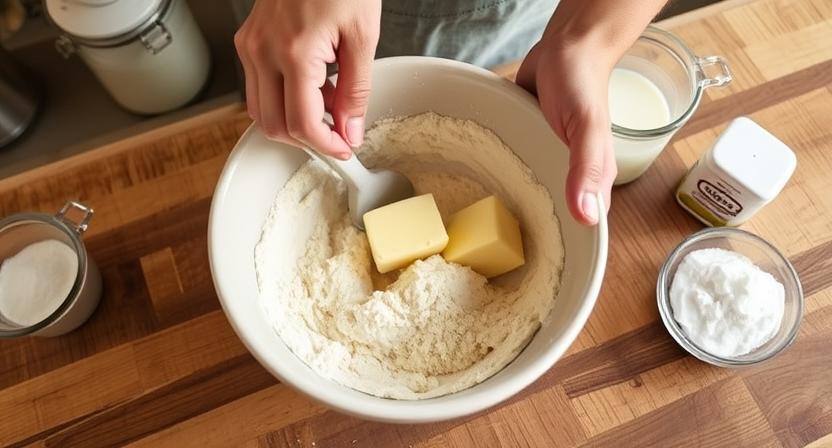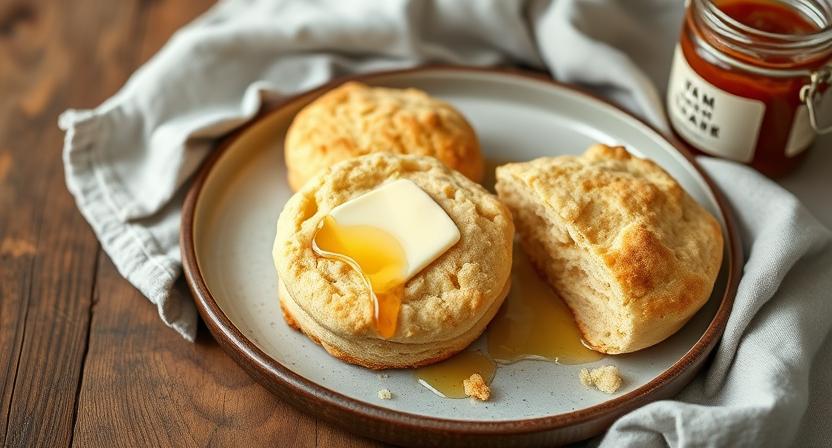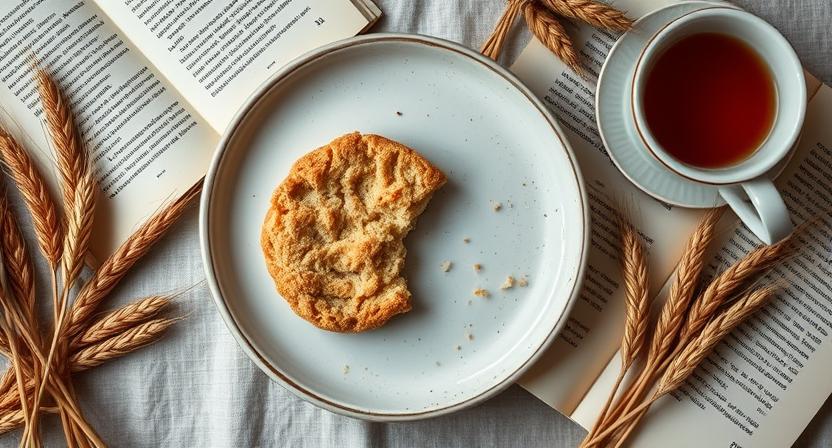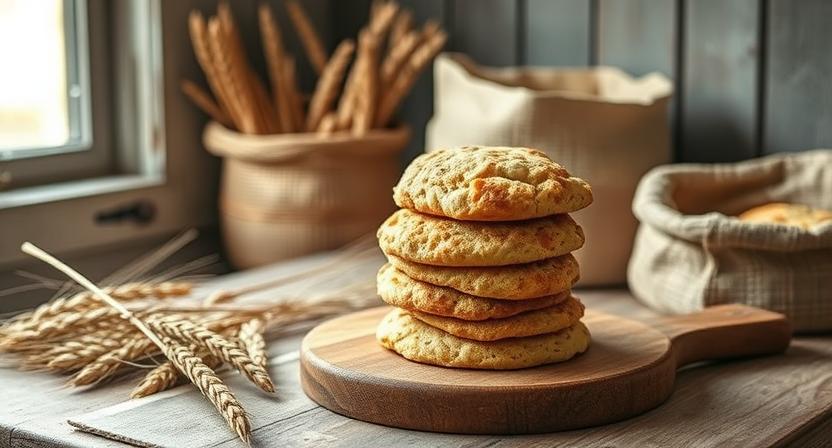Baking with ancient grains revives tradition in addition to flavour. The restoring heritage grains einkorn biscuit recipe, designed for people who appreciate history, health, and robust flavour, is examined in this guide. One of the first wheats to be produced, Einkorn flour has a rich flavour and is more easily digested, making it a special option for contemporary kitchens. This recipe brings baking closer to its traditional roots if you’re ready to do so.

Why Choose Einkorn for Your Biscuits?
The earliest wheat known to science is Einkorn. Its nutritional profile and purity are maintained because it is not hybridised, in contrast to modern wheat. Einkorn flour biscuits have a soft, tender texture and a rich, somewhat nutty flavour.
Compared to regular wheat, this grain has higher quantities of lutein and protein. Einkorn might be a better choice for people who are gluten sensitive but not coeliac.
The Health Appeal of an Ancient Grain Biscuit Recipe
Using ancient grains like einkorn is a nutrient-dense decision, not just a fad. These grains are frequently easier to digest and contain more micronutrients. By omitting the bleached flours and additives present in conventional versions, this recipe for ancient grain biscuits uses less processed components.
The outcome? Delicious biscuits that taste even better as they feel.
Ingredients You’ll Need for Authentic Flavor
Here’s a list of basic ingredients required for this wholesome recipe. All are simple and found in most kitchens:
- Two cups of natural einkorn flour.
- Baking powder, 1 tablespoon
- Half a teaspoon of sea salt
- Six tablespoons of cold, chopped unsalted butter
- 3/4 cup of whole milk (for tang, use buttermilk)
- One teaspoon of honey is optional for a subtle sweetness boost.
This minimalist list keeps the focus on the star ingredient—einkorn flour.
Restoring Heritage Grains Einkorn Biscuit Recipe Easy and Step-by-Step
This section explains the simple steps involved in making heritage grain einkorn biscuits. All you need are basic tools and your hands—no mixer.
1. Preheat Your Oven
The oven should be set to 425°F (220°C). Line a baking sheet with parchment paper or lightly grease it.
2. Mix Dry Ingredients
Mix the baking powder, salt, and einkorn flour in a big bowl. To uniformly spread the leavening, give it a good stir.
3. Add Butter
Using a pastry cutter or your fingertips, cut in the cold butter. The goal is pea-sized crumbs. Flakiness will later be determined by the texture at this point.

4. Add Milk
Stirring, slowly pour in the milk. A soft dough—not too sticky or wet—is what you want.
5. Form and Cut Biscuits
Place the dough on a surface dusted with flour. Pat into a 3/4-inch thick round after gently kneading three to four times. Cut rounds using a tiny glass or a biscuit cutter.
6. Bake to Perfection
On the tray, arrange the biscuits with a small gap between them. Golden brown, 12 to 15 minutes in the oven.
Farmhouse Biscuit Recipe With a Heritage Twist
This biscuit isn’t like the others. This recipe’s grounded, rustic quality is what distinguishes it as a farmhouse biscuit. It brings back memories of carefully cooked meals and wood-burning ovens.
Pair these biscuits with farmhouse favorites like:
- Herb-infused gravy
- Raw honey and fresh butter
- Jams created at home
- Eggs or sliced ham for breakfast sandwiches
They work equally well for breakfast, lunch, or as a side for hearty dinners.
Tips to Master This Restoring Heritage Grains Einkorn Biscuit Recipe
Don’t Overwork the Dough
Gluten from Einkorn acts differently. To keep biscuits soft, handle them gently.
Chill Butter Before Use
As your biscuits bake, the steam produced by the cold butter helps them rise.
Use a Sharp Cutter
Better rising is achieved with a clean cut. The cutter flattens layers and seals edges if you twist it.
Make It Special: Variations and Additions
While adhering to the base of the recovering heritage grains einkorn biscuit recipe, there are many ways to customise your biscuits. Try these choices:
- To add a savoury bite, add some shredded cheese.
- Add herbs such as thyme or rosemary.
- Before baking, spread garlic butter on top.
- For a Southern-style biscuit, use buttermilk.
Each addition complements the deep flavor of einkorn without overpowering it.
From Seed to Table: The Story Behind Restoring Heritage Grains Einkorn Biscuit Recipe
This recipe is more than just a list of guidelines; it’s a link to environmentally conscious farming methods. Heritage grain restoration supports soil health and biodiversity preservation.
Small-scale farmers who opt not to cultivate contemporary, genetically modified wheat benefit from the use of einkorn. Every biscuit narrates a tale of heritage, sustainability, and care.

How to Store and Reheat Your Einkorn Biscuits
Proper storage keeps flavor and texture intact. After cooling, place biscuits in an airtight container.
- Room temperature: for a maximum of two days
- Cooler: For up to a week
- Freezer: For up to three months, wrap each item separately and freeze.
To reheat, warm in a 300°F oven for 5–7 minutes. Avoid microwaving to preserve flakiness.
Need more Information? Also read these topics for more information
Man Dip Recipe: Easy, Hearty & Perfect for Any Occasion
Blue Jam Garlic Aioli Recipe for Bold and Easy Flavor
Final Thoughts on This Restoring Heritage Grains Einkorn Biscuit Recipe
Einkorn flour adds flavour, nutrition, and satisfaction to baking. Tradition and a contemporary approach to health-conscious cooking are combined in this recipe for heritage grain einkorn biscuits.
This dish works well whether you’re trying to reconnect with your family or you’re just seeking a healthy shift. It’s a step towards more flavourful outcomes, thoughtful preparation, and simpler ingredients.
It might become your new baking ritual if you give it a try.
